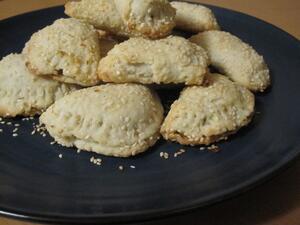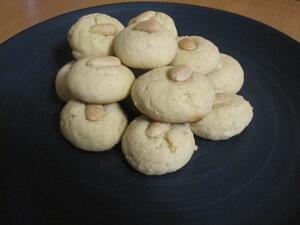Eating Jewish: Iraqi Purim Delicacies
With preparation for Purim in full swing, there is no doubt that many people are thinking about Hamantaschen, which has become synonymous with this holiday in North America. Although these triangular cookies are delicious and I love to both eat and make them during Purim celebrations, I also wanted to explore what other dishes are prepared for this holiday.
Being more familiar with the Purim food of the Ashkenazi community, I began to look at the dishes of Sephardic Jews. I came across many delicious recipes from Jewish communities across the Sephardic world, but it was the two following Iraqi recipes that particularly stood out for me. Having never prepared or eaten food from this community, I knew I wanted to take this time to try these out.
The two recipes I decided to make are traditionally associated with Purim in the Iraqi community and also correspond to the food symbolism that is connected with this holiday across the Jewish community. The chickpea filling of sambusak el tawa is a traditional ingredient on both Sephardic and Ashkenazic Purim tables because it is a reminder of the vegetarian diet which consisted of legumes, nuts and seeds that Esther maintained while living in the king’s palace in order to keep kosher. The turnovers with their filling is also representative of the secrets, the intrigues and the hidden elements of the Purim story. On the other hand, there is a strong emphasis on sweets during the holiday as a symbolic way to wish for a “good lot” and the hadgi badah cookies are a tasty way to do so. The chickpea turnovers would traditionally be part of a Sephardic Purim seudah or feast, however along with the hadgi badah I think they would also be a great addition to any mishloach manot.
When making the turnovers it is best to start by making the dough because it will have to be refrigerated before use. The dough I chose produces a flaky pastry that comes together easily. However it should be noted that the recipe produces a crumbly dough, akin to what you would get when making scones, and I found that I had to add more water than what the recipe originally called for, so just keep adding a tablespoon of water at a time until it holds together. Once the dough is resting, you can move on to preparing the filling, which comes together quickly (especially if you’re using canned chickpeas as I did). Although these sambusak are traditionally fried, I chose to bake these turnovers because choosing the healthier option allows me to justify eating three of these in one sitting and also makes for a clean kitchen that isn’t covered in oil. These turnovers are delicious straight out of the oven but just as good eaten at room temperature. However you choose to eat them, what you get is a flaky dough that surrounds a delicately spiced filling that is subtle and similar to the flavors you might find in an Indian dish.
Hadgi badah are cookies that are full of flavor and easy to make, with the batter coming together with minimal effort. The cardamom in this recipe shines through but is in no way over powering, while incorporating orange blossom water into this recipe by moistening your hands before rolling the batter into small balls allows for the subtle presence of its distinctive taste. These two flavors complement each other wonderfully in this cookie and they would be perfect alongside a cup of tea or as a light dessert at the end of a meal. These cookies can also be made without the flour for Passover, a recipe that I look forward to sharing in a few weeks time.
These are two wonderful recipes will add a taste of the Iraqi Jewish community to your Purim celebrations and I hope you enjoy them as much as I did!
Sambusak el Tawa (Iraqi chickpea turnovers)
From Gil Mark’s The World of Jewish Cooking
Dough
2 ½ cups all-purpose flour
½ cup (1 stick) butter or margarine, chilled
¼ cup vegetable oil or 6 tablespoons vegetable shortening
1 teaspoon mild vinegar or lemon juice
1 teaspoon salt
About 5 to 10 tablespoons ice water or chilled seltzer
Chickpea Filling
2 tablespoons vegetable oil
2 medium yellow onions, chopped (about 1 cup)
1 teaspoon ground cumin
¼ teaspoon ground turmeric
About ¼ salt (if required add more salt after all the ingredients have been combined)
Ground black pepper to taste
2 cups cooked chickpeas, mashed (one 15 ounce can is the perfect amount)
-
Place the flour in a large bowl or on a pastry board and make a well in the center. Place the butter or margarine and oil or shortening in the well and, using the tips of your fingers, a pastry blender, or two knives cutting scissor fashion, cut in the fat until the mixture resembles coarse crumbs.
-
Stir the vinegar or lemon juice and salt into the ice water or seltzer. Sprinkle the water, 1 tablespoon at a time, over a section of the flour. Gently mix with a fork to moisten. Push the moistened section aside and continue adding enough water to make a soft dough that just holds together. (The dough should be neither wet nor crumbly, as too much liquid and overmixing reduce tenderness.)
-
Place the dough on a lightly floured surface and knead briefly with the heel of your hand. Form into a ball, flatten slightly, cover with plastic wrap, and refrigerate for at least 30 minutes or up to 1 week. The dough can also be frozen for up to 3 months. (Chilling makes the dough easier to handle and more tender.) Let the chilled dough stand at room temperature until workable, about 1 hour, before rolling.
-
For the filling, heat oil in a large skillet over medium heat. Add the onions and sauté until soft and translucent, 5 to 10 minutes. Stir in the cumin, turmeric, salt, and pepper. Add the chickpeas and cook until dry.
-
Form the dough into 1-inch balls. Flatten slightly, then press the bottoms into the sesame seeds. Roll into 3-inch rounds.
-
Place a heaping teaspoon of the filling in the center of each dough round. Fold an edge over the filling to form a half-moon shape and crimp the rounded edge or press with the tines of a fork. (The pastries can be prepared ahead to this point and frozen. Do not thaw; increase the baking time by about 10 minutes.)
-
Preheat oven to 375 degrees.
-
Place the sambusak on baking sheets. Bake until golden brown, about 20 minutes. Serve warm or at room temperature.
Hadgi Badah
From Gil Mark’s Encyclopedia of Jewish Food
2 ¼ cups all purpose flour
1 teaspoon ground cardamom
½ teaspoon salt
¼ teaspoon double-acting baking powder
1 1/3 cups sugar
4 large eggs
2 cups ground blanched almonds
Rose water or orange blossom water for moistening hands (optional)
About 48 whole blanched almonds or pistachios (optional)
-
Preheat oven to 350 degrees. Line two large baking sheets with parchment paper or grease the baking sheets.
-
In a small bowl, shift together the flour, cardamom, salt and baking powder. In a large bowl, beat together the sugar and eggs until light and creamy, about 2 to 3 minutes. Stir in the flour mixture, then the ground almonds.
-
Moisten your hands with rose water or orange blossom water, if desired, and form the dough into 1-inch ball (I used a tablespoon to scoop the dough out of the bowl so they would be even in size). Place on the prepared baking sheets and flatten slightly. If using, press a whole almond or pistachio into the center of each cookie.
-
Bake until lightly browned, about 10-12 minutes. Let the cookies stand until firm, about 1 minute, then transfer to a wire rack and let cook completely. Store in an airtight container at room temperature for up to 1 week or in the freezer for up to 6 months.









Iraq is not in Sepharad, and Iraqi Jews are not typically Sephardi. The flattening of global Jewry to a false dichotomy of either Ashkenazi or Sephardi is ahistorical and increasingly socially unacceptable. Especially coming from a writer who isn't even Jewish at all - as I understand it, Romanow (the author of this article) is not Jewish, but an enthusiast and student of Jewish food culture. Which is fine, but she should really be more cognizant of the intricacies of Jewish ethnic groups if she is going to expound on them.
I'm looking at my copy of Rabbi Mark's "The World of Jewish Cooking" (page 334), the ingredients for his Hadgi Badah are simple:
Almond meal flour (he calls it ground blanched almonds)
Sugar
Egg whites
Cardamom
(Slivered almonds optional decoration).
That's it.
I have his books. I can see if his encyclopedia or his baking book have different versions...